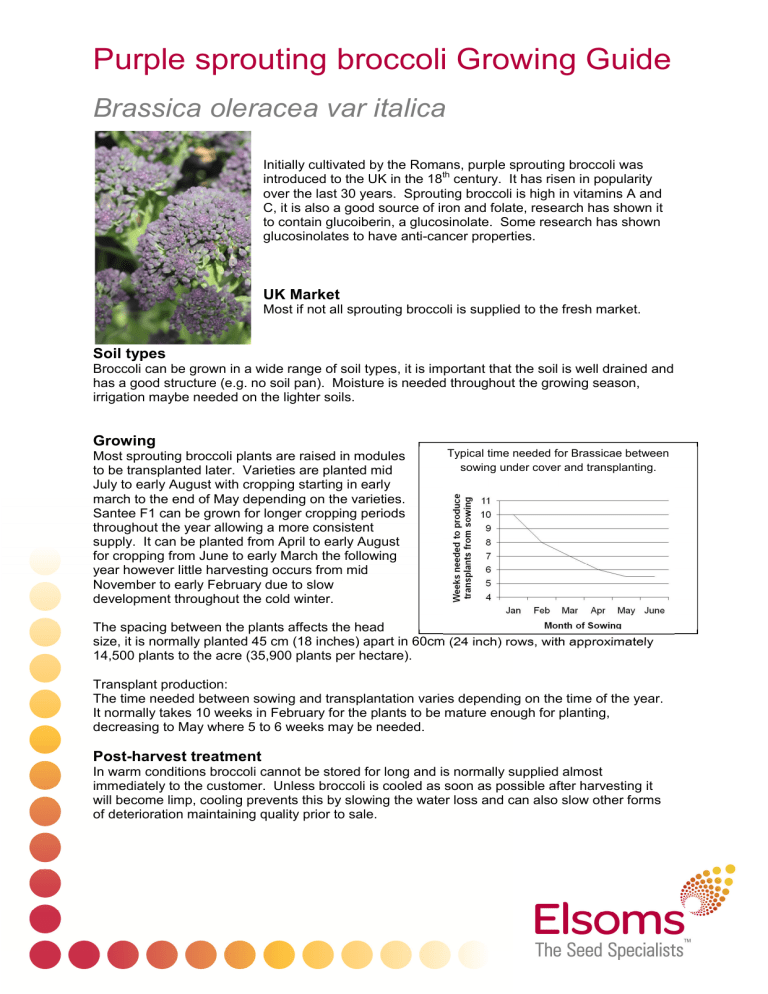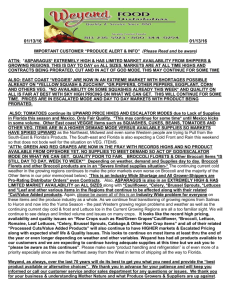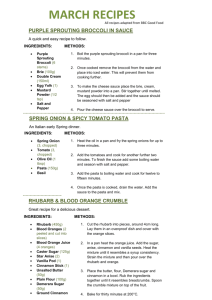Purple sprouting broccoli Growing Guide

Purple sprouting broccoli Growing Guide
Brassica oleracea var italica
Initially cultivated by the Romans, purple sprouting broccoli was introduced to the UK in the 18 th
century. It has risen in popularity over the last 30 years. Sprouting broccoli is high in vitamins A and
C, it is also a good source of iron and folate, research has shown it to contain glucoiberin, a glucosinolate. Some research has shown glucosinolates to have anti-cancer properties.
UK Market
Most if not all sprouting broccoli is supplied to the fresh market.
Soil types
Broccoli can be grown in a wide range of soil types, it is important that the soil is well drained and has a good structure (e.g. no soil pan). Moisture is needed throughout the growing season, irrigation maybe needed on the lighter soils.
Growing
Most sprouting broccoli plants are raised in modules Typical time needed for Brassicae between to be transplanted later. Varieties are planted mid
July to early August with cropping starting in early march to the end of May depending on the varieties.
Santee F1 can be grown for longer cropping periods throughout the year allowing a more consistent supply. It can be planted from April to early August for cropping from June to early March the following year however little harvesting occurs from mid sowing under cover and transplanting.
November to early February due to slow development throughout the cold winter.
The spacing between the plants affects the head size, it is normally planted 45 cm (18 inches) apart in 60cm (24 inch) rows, with approximately
14,500 plants to the acre (35,900 plants per hectare).
Transplant production:
The time needed between sowing and transplantation varies depending on the time of the year.
It normally takes 10 weeks in February for the plants to be mature enough for planting, decreasing to May where 5 to 6 weeks may be needed.
Post-harvest treatment
In warm conditions broccoli cannot be stored for long and is normally supplied almost immediately to the customer. Unless broccoli is cooled as soon as possible after harvesting it will become limp, cooling prevents this by slowing the water loss and can also slow other forms of deterioration maintaining quality prior to sale.
Purple sprouting broccoli Growing Guide
Brassica oleracea var italica
Varieties available from Elsoms seeds
Purple varieties:
Santee F1
The market leader for summer and autumn harvest. A beautiful, bushy plant which is suited to multiple harvesting from June to early November. Can also be used in the spring.
Rioja F1
One of our most recent introductions, Rioja has a very vigorous habit which is suited to early spring harvests.
Mendocino F1
Very uniform hybrid producing good yields of excellent quality spears. Follows Santee and Rioja giving consistently high quality in this ‘early maincrop’ period.
Claret
First hybrid-sprouting broccoli, bred by Elsoms. Very good quality and uniformity. Large vigorous plant producing heavy yields of quality spears.
Pozo F1
Attractive hybrid with a similar maturity to Claret. It produces strong healthy plants giving good yields of nice quality spears.
NEW BE 2862 F1
Our newest variety, maturing approximately a week later than Claret.
White/gold:
Burbank F1
Our first white/gold hybrid, producing a strong, vigorous plant with a high yield of succulent spears.
Cropping guide
Suggested planting/cropping times
Feb Mar Apr May Jun Jul Aug Sep Oct Nov
Purple sprouting
Santee F1
Rioja F1
Mendocino F1
Claret
Pozo F1
NEW BE 2862 F1
White/Gold sprouting
Burbank F1
Planting Maturity
Our breeding program is a joint venture with Bejo Zaden B.V. of Holland. By researching and trialling on a range of UK and European sites we are introducing new improved hybrids which extend the current harvesting period.
Further information
For further information on the different varieties, seed treatments, pests and disease please contact your regional vegetable seed specialist or see the Elsoms Seeds catalogue.
Links
Elsoms Seeds website and catalogue: http://www.elsoms.com/
The information provided in this sheet is intended for general guidance only and is correct to the best of our knowledge. Please be aware that variations in the growing environment and climatic conditions can render this information inaccurate. For more specific advice about fertiliser use please contact a FACTS certified advisor.
KCW/JAN12




